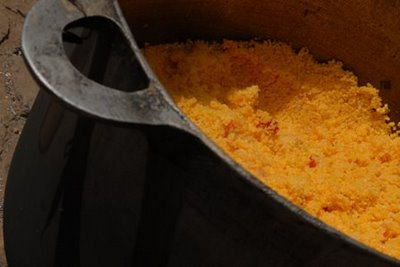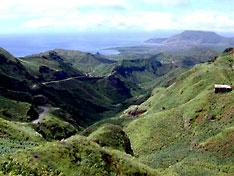Cape Verde

The Cape Verdean archipelago (island chain) had no known inhabitants before colonial times. It is believed that Arab sailors were aware of the islands by the tenth or eleventh century.
From 1455 until its independence in 1975, Cape Verde was a colony of Portugal. The islands were first reached around 1455 by captains sailing for Portugal's Prince Henry "The Navigator." They were looking for new trade routes and African gold, and they began to sail along the upper West African coast in the early fifteenth century.
The Portuguese based their slave-trading economy on these islands in the seventeenth to nineteenth centuries. Slaves worked on Cape Verdean sugar plantations, and they did general labor and household work. It was common for slave owners to have children with their servants. That is largely how today's nativeCrioulo (Creole) population evolved.
Since 1975, Cape Verde has been governed by a National Assembly. A single party, the African Party, was in power from independence until Cape Verde's first elections involving several parties in 1991.
The Republic of Cape Verde is an archipelago nation of nine main islands. It lies about 300 miles (483 kilometers) off the west coast of Senegal. The horseshoe-shaped archipelago consists of two island groups. They are the northern Barlavento islands and the southern Sotavento islands. Some islands are flat and sandy. Others have mountains (notably Mount Fogo) that rise more than 9,000 feet (2,743 meters) above the sea. The capital, Praia, is located on the largest island, São Tiago.
Islands: The islands of Cape Verde are a bewitching blend of Portuguese and African influences, as seen in the many European –style buildings dotted amongst the ever-changing landscape, the unique musical styles, and the fascinating mixture of African and European custom and conduct. It's most obvious in the foods on offer, with Portuguese foods (such as fish- and seafood-based dishes, olive oil, garlic, lemon and sausage) and African foods (stews, beans, maize and tropical crops) comfortably combined on most menus.
This is the Boa Vista island. This is the Brava island. This is the Fogo island.



This is the Maio island. This is the S. Vincente Island. This is the Sal island.



Food: Cape Verde's dry, tropical island environment and its role in Portugal's 15th-century colonizations have shaped its cooking traditions. Enslaved Africans brought knowledge of growing and cooking tropical crops. The Portuguese brought livestock. They used Cape Verde for feeding the crews of their sailing ships and as an experimental station for growing foods from the Americas, such as corn, hot peppers, pumpkins, and cassava. They also transplanted sugar,bananas, mangos, papayas, and other tropical crops from Asia. National food preferences, reflected in ritual foods, include an affection for dried corn, either whole kernels (hominy/samp) or ground to various degrees of fineness. The national dish, cachupa, is a stew of hominy and beans with fish or meat. It means home to Cape Verdeans everywhere. Xerem, dried corn pounded in mortar to the fineness of rice, is the staple of feasts. And kuskus, ground finer still and steamed in a distinctive ceramic pot called a binde, is a special treat served hot with butter and milk (kuskus ku leite) or molasses (kuskus ku mel). Cape Verdean Americans maintain most of these national tastes.
This is Xerem a common food in Cape Verde. This is also a very common food in Cape Verde called Cachupa.


Flora and Fauna: The flora on Cape Verde is quite limited, however, there are 300 species, most of which were imported by the Portuguese navigators. There is not much fauna on the land. On the other hand, the marine fauna is very rich and diverse, to the delight of divers and fishermen.
This a a beautiful view from the flora and This is to see how beautiful the sea in Cape Verde
fauna in Cape Verde. is.


Now i will show you a video about Cape Verde
.
Comments (16)
Bella Brain said
at 11:52 am on Dec 7, 2012
nice page bernardddd.... i like the beaches :)
Bernardo Silva said
at 11:55 am on Dec 7, 2012
Thanks Bella
Teresa said
at 1:18 pm on Dec 9, 2012
Really nice Bernardo good job
Bernardo Silva said
at 8:40 am on Dec 13, 2012
Thank You Teresa
claudialombaviana@... said
at 9:48 am on Dec 13, 2012
Well done Bernard! I love the use of images and thought it was very attractive. GREAT Job! (:
Bernardo Silva said
at 9:57 am on Dec 13, 2012
Thank You Claudia. You are such a good friend.
Inês Rodrigues dos Santos said
at 9:54 am on Dec 13, 2012
wow yours is really good! the images are reallyyyy neat and its very eye catching. also good info. excellent
Bernardo Silva said
at 9:57 am on Dec 13, 2012
Thank you very much ines you are such a great friend. Thank You
claudialombaviana@... said
at 9:58 am on Dec 13, 2012
Its apleasure Bernard (:
Bernardo Silva said
at 10:01 am on Dec 13, 2012
LOLOLOLOLOLOLOLOLOLOLOLOLOLOLOLOLOLOLOLOLOLOLOLOLOLOLOLOLOLOLOLOLOLOLOLOLOL
Tiago said
at 9:59 am on Dec 13, 2012
I think everything looks good except the food. i think the food is vry attractive for a person that is going to cabo verde and looks at the food. but the rest is very attractive and the colours are very attractive which is very good Benni
Inês Rodrigues dos Santos said
at 9:59 am on Dec 13, 2012
No problemo bernie bear.bffffffsssss
Bernardo Silva said
at 10:02 am on Dec 13, 2012
yaaaaaaaaaaaaaaaaaaaaaaaaaaaaaaaaaaaaaaaaaaaaaaaaaaaaaaaaaaaaaaaaaaaaaaaaaaaaaaaaaaaaaaaaaaaaaaaaaaaaaaaaaaaaaaaaaaaaaaaaaaaaaaaaaaaaaaaaaaaaaaaayyyyyyyyyyyyyyyyyyyyyyyyyyyyyyyyyyyyyyyyyyyyyyyyyyyyyyyyyyyyyyyyyyyyyyyyyyyyyyyyyyyyyyyyyyyyyyyyyyyyyyyyyyyyyyyyyyyyyyyyyyyyyyyyyyyyyyyyyyyyyyyyyyyyyyyyyyyyyyyyyyyyyyyyyyyyyyyyyyyyyyyyyyyyyyyyyyyyyyyyyyyyyyyyyyyyyyyyyyyyyyyyyyyyyyyyyyyyyyyyyyyyyyyyyyyyyyyyyyyyyyyyyyyyyyyyyyyyyyyyyyyyyyyyyyyyyyyyyyyyyyyyyyyyyyyyyyyyyyyyyyyyyyyyyyyyyyyyyyyyyyyyyyyyyyyyyyyyyyyyyyyyyyyyyyyyyyyy
Bernardo Silva said
at 10:03 am on Dec 13, 2012
LOOOOOOOOOOOOOOOOOOOOOOOOOOOOOOOOOOOOOOOOOOOOOOOOOOOOOOOOOOOOOL
Bernardo Silva said
at 10:04 am on Dec 13, 2012
I LOVE YOU GUYS
Bernardo Silva said
at 10:05 am on Dec 13, 2012
hahaha
You don't have permission to comment on this page.